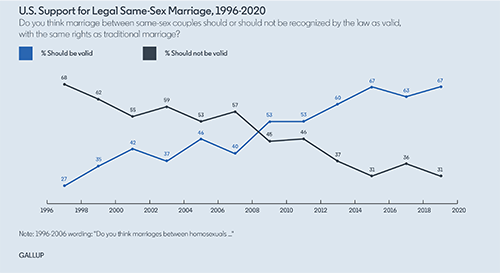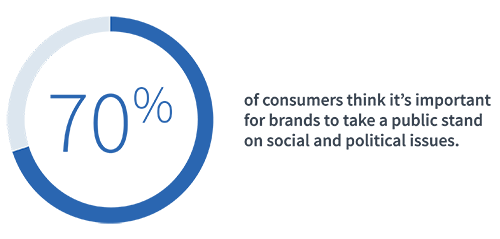Purpose and Pride: How Financial Institutions Are Embracing the LGBTQ+ Community
What began more than 50 years ago as a march in New York City calling for equal rights for gay, lesbian, bisexual and trans people, is today a worldwide, month-long celebration of LGBTQ+ voices and community presence.
In 2021, Pride Month is a time of advocacy and activism, a time to look back on the progress that’s been made, and a time to look ahead to the work that remains. It’s also a time for brands to demonstrate their allyship to the LGBTQ+ community both internally and externally. Pride month offers all a chance to celebrate the LGBTQ+ community and the actions that have been taken around LGBTQ+ inclusivity during the other 11 months of the year. It’s a moment to show the purpose behind the pride.
Brands have long been part of pride celebrations, and while corporate participation is visible during Pride month, the reality is that brands still have some wariness around LGBTQ+ inclusivity. A recent study by P&G and GLAAD found that 39% of advertisers reported weak support among leadership for featuring LGBTQ+ people and scenarios in advertising.
Support would likely have been weaker only a few years ago. In 2010, national support for same-sex marriage was less than 50%, according to Gallup. By the time the Supreme Court legalized same-sex marriage in 2015, public support was at 55%. Today it’s at 67%.
Support for LGBTQ+ Equity in the U.S. Continues to Grow
Brands across many industries, including the financial services industry, have been keeping pace by creating corporate cultures that are inclusive for LGBTQ+ employees, their families, customers, and all members of the community.
Authenticity for Brands, Employees, and Customers
To be authentic allies, financial services brands need to ensure that employees can be their authentic selves in the workplace. An example of this is a program Goldman Sachs offers called Straight Talk, an interactive session held by an LGBTQ+ senior management ally and a member of the LGBTQ+ community. These sessions explore the experiences of LGBTQ+ employees and address how individuals can help foster an inclusive workplace. A concrete example of how this comes to life in Goldman Sachs is that employees use preferred pronouns on the company’s intranet. The aim is at celebrating being your authentic self in the workplace and beyond.
Citibank helps its customers be their authentic selves with a new feature that lets transgender and non-binary customers use their chosen first name on credit cards. Called True Name and launched in partnership with Mastercard, Citibank also introduced a television ad by cinematographer Bianca Cline and featuring actor Asha Doucet, both of whom identify as transgender. The spot shows a young Black trans man and his girlfriend finding a name that matches his identity.
Making a Commitment to the Company
But building an authentically inclusive company culture often requires actions that customers and many employees might not see. Consider the JPMorgan Chase Global Supplier Diversity Program, which connects diverse businesses with opportunities to do business with one of the world’s largest investment banks. Investment in diverse suppliers is critical in creating both a more inclusive work environment and a more equitable business community.
William Kapfer, Head of the Global Supplier Diversity program, put it this way:
It’s not surprising that in 2021, JPMorgan Chase scored 100 out of 100 on the Human Rights Campaign’s Corporate Equality Index, which is “the national benchmarking tool on corporate policies, practices and benefits pertinent to lesbian, gay, bisexual, transgender and queer employees”.
Fostering the Next Generation of LGBTQ+ Leaders and Entrepreneurs in Financial Services
JPMorgan Chase is among the corporate sponsors of StartOut, which for more than a decade has helped the LGBTQ+ entrepreneurial community with the resources entrepreneurs need to succeed. Among the businesses helped by StartOut is Daylight, the first digital bank in the United States designed for and by the LGBTQ+ community. Daylight is also supported by Visa as part of its Visa Everywhere Initiative, which awards financial services innovators grants, and puts out a special call for ideas from LGBTQ+ innovators.
The founders of Daylight wanted to create a financial services business that didn’t engage in “rainbow washing.” They believe customers can see through “performative allyship” and expect brands to demonstrate a genuine and ongoing commitment to LGBTQ+ stakeholders.
Research backs up Daylight’s hunch that people want to do business with brands that align with their values. A recent survey found that:
Inclusion Is a Year-Round Effort
To really create change, we must consider how we authentically talk about and enact change year round. This cannot be a conversation that only happens when we celebrate Pride, but one that all organizations must consider throughout the year. As a matter of fact, GLAAD and P&G found that 81% of advertisers agree that “an inauthentic execution of LGBTQ+ people and scenarios would lead to a larger backlash than not featuring them in ads at all.”
We thought this recent article by Advertising Week 360 offered some great best practices for marketers to consider around authentically reaching the LGBTQ+ community.
Be intersectional in your LGBTQ+ storytelling:
A large number of LGBTQ+ advertising images show white men. Marketers should include images that represent the full racial, gender, and social diversity of the LGBTQ+ community.
Show LGBTQ+ people in your internal and external work all year:
Including LGBTQ+ representation outside the month of June offers marketers an opportunity to show LGBTQ+ people engaging in a full range of activities and settings.
Represent LGBTQ+ families in their diversity:
Just as traditional LGBTQ+ representation often focuses on white men, LGBTQ+ families in marketing images are narrowly depicted as white and well-off. There’s increasing demand to show LGBTQ+ families that don’t fit the stereotype.
The result is about more than marketing a brand. GLAAD and P&G report that 61% of advertisers strongly agree that featuring LGBTQ+ people and scenarios in advertising helps consumers understand and respect the LGBTQ+ community.
Because of the important role financial services play in building a more equitable society, how marketers in the industry take action on LGBTQ+ inclusivity can bring immediate and important benefits to LGBTQ+ stakeholders, as well as show the way forward for other industries.
What best practices do you follow as an inclusive marketer? For more tips, subscribe to the LinkedIn Marketing Solutions Blog.






